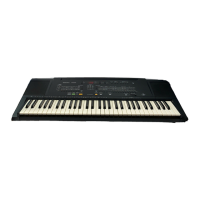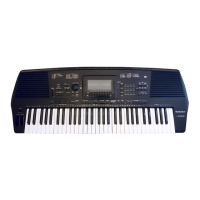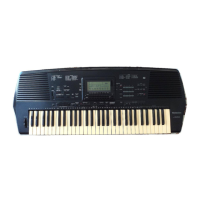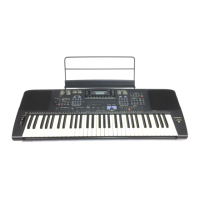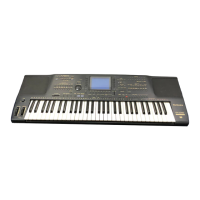Part
III
II.
Storing
the
DRUMS
part
1.
Press the RECORD button
in
the COMPOSER
section. " d r " appears
on
the display. The
metronome starts.
(If the DRUMS part has not
been cleared, any previously stored
DRUMS
rhythm can also
be
heard.)
RECORD
o
o
2.
Play the desired percussive keys
on
the.
key-
board
in
time with the metronome for two
measures.
-
r--
-~
-
r-
r-r-
r--
--
•
You
can distinguish the 1 st measure from the
2nd measure
by
the horizontal lines
on
the
display.
""
feLl
2nd measure
1st measure
• If you press a percussive key while pressing
the
INSTR ERASE button, that instrument will
be
deleted for as long as the INSTR ERASE
button is pressed.
•
Up
to four instruments can sound with the same
timing. However, if the
MANUAL PERCUS-
SION is played with the COMPOSER during
playback, the number of
DRUMS instruments
that sound becomes less.
• Adjust the tempo as necessary.
• If either QUANTIZE level is selected during
recording, any unevenness
in
the timing of the
performance
is
smoothed out. The default set-
.
tingis
).
(Refer to page 19.)
Recording
and
playback
• Any contents stored
in
the DRUMS part can
be
deleted
by
pressing the CLEAR button.
o
.
"'
r-
r-
r-r-
r--
~.r-'--'
~
r-
r-
r-r--
Store the following example:
Hi-hat closed
1st measure
Ie
l I j 1 1 I j
Snare drum
Ie
,;
Bass drum
r
,c
r
;
, C
2nd measure
1 I j 1 1 1 j 1
J
J
i
, C i
, C
Part
III
III.
Storing
the
BASS
part
1.
Press the RECORD button
in
the COMPOSER
section. The display changes to show
"
bAS
".
In
addition to the metronome and
the
DRUMS pattern just stored, any previously
stored
BASS and ACCOMP patterns now
sound.
RECORD
o
o
• If you wish
to
delete all the previously stored
BASS part, press the CLEAR button.
2.
Use the 16 buttons
in
the horizontal row of the
SOUND SELECT matrix to select the BASS
sound.
SOUNO SELECT
Recording
and
playback
I
",-
Olf~
O
HARPSI'
HAWAI~
XYLO-
PIPE PIPE
FRENCH
ACCOR-
PAN
o
PIANO
1
CHORO
GUITAR GUITAR
GLOCKEN
PHONE
ORGAN
1
ORGAN
2
VIOLIN
BRASS
HORN
DlON
OBOE
FLUTE
SPEllAL
1
SPECW.
4
O
JAZZ
MUTE
JAZZ JAZZ
TROM-
TENOR
.
o
PIANO
2 E
PIANO
1
GUITAR
GUITAR
BANJO
VIBEIDNE
ORGAN
1
ORGAN2
STRINGS
TRUMPET
BONE
SAX
CLARINET
FLUTE
SPECIAL2
SPEClAL5
O
SOLID
ROCK
STEEL
POP
SYNTH
SYNTH SYNTH
ALTO
HAR-
o E
GRAND
E
PIANO
2
GUITAR
GUITAR
CLAVI
KALIMBA
DRUM
ORGAN
STRING
BRASS
1
BRASS
2
SAX
MONICA
WHISTLE
Sl'ECW.3
SI'ECIAl6
BASS·O
ACOtfS'ICIA~ST1CI
ELE';"'
IC
I
ElE~TRIC
I
CHO~
I
C~R
IOR~ANIOR~ANIBOWEDI
CEllO
I
TUBA
I
SY~TH
I
SY~TH
I
SY~TH
I
SY~TH
I
SY~H
000
0 0 0 0 0 0 0 0 0 0 0 0 0
'
ON
O
d d
dOd
d d d d d d d d
O'
d
d~~~'
,
~
3.
Play two measures of the BASS pattern
on
the
keyboard.
• Record the performance
in
C major for correct
chord progressions during playback.
• The BASS pattern can be played
on
the entire
keyboard, regardless of the indicated split
point. However, those notes played
on
C4
or
higher will sound
in
a lower octave.
• Play the BASS pattern for two measures to
store it. Then, as the two-measure pattern is
repeated, you can play the keyboard to add
notes to the pattern. The final version of the
BASS pattern
is
the one that is stored.
Here is what you play:
BASS part I
t)l!!
J
, J
i
Select the BASS sound (indicated
in
the bottom row) with these buttons.
1
l'
• Adjust the tempo as necessary.
• If either QUANTIZE level is selected during
recording, any unevenness
in
the timing of the
performance is smoothed out. The default set-
ting is
).
(Refer to page 19.)
J
,JOljJJ

